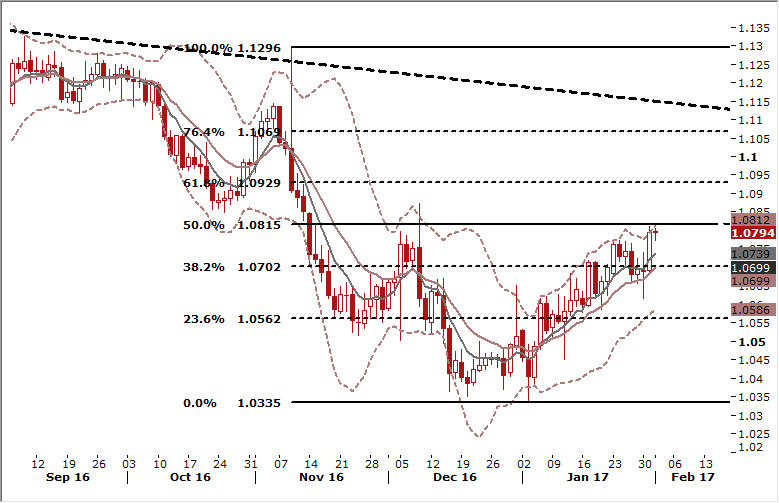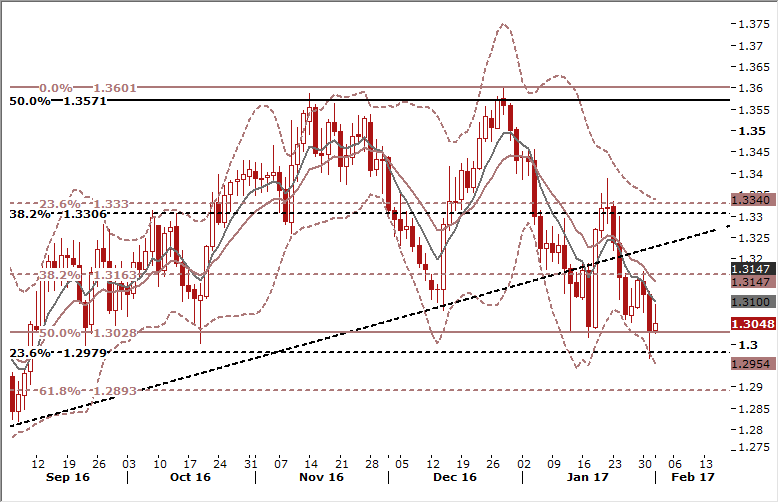Macroeconomic overview
A senior trade adviser to the president Donald Trump, Peter Navarro, said the euro was "grossly undervalued". Navarro's comments were followed by Trump himself, who complained that "every other country lives on devaluation" while the United States "sit(s) there like a bunch of dummies". As we expected and highlighted many times in our publications - it looks like investors betting on the USD appreciation under Trump presidency were wrong.
The comments from Trump at the end of a White House meeting with pharmaceutical executives, as well as from trade adviser Peter Navarro in a newspaper interview, were the starkest indication yet that the first-term Republican president is prepared to jettison two decades of "strong dollar" policies advocated by predecessors dating back to the Clinton administration.
The criticism also signals a weakening of the U.S. commitment to an agreement among the financial leaders of the world's top 20 economies, struck after the 2008 financial crisis, that countries would not pursue policies to target exchange rates for competitive purposes.
On the other hand, macroeconomic data from the Eurozone suggest that ECB will have to revise its projections soon.
The monetary policy implications of the latest macro data can be best assessed by comparing the actual growth and inflation outcomes to the ECB forecasts published on 8 December. GDP growth in the fourth quarter 2016 seems to have been much in line with the ECB’s fan chart, while, at face value, survey-based information available for January suggests some slight upside risks to the central bank’s growth forecast for the first quarter 2017. Some upward revisions to previous GDP data strengthen the carryover entering 2017. Therefore, the growth picture is developing better than the ECB predicted in December. On the inflation front, the latest data have clearly exceeded the central bank’s expectations. The ECB will almost certainly clearly revise up its CPI projection for this year. If it leaves the trajectory for the remaining part of the forecast horizon, it will imply a humped-shaped inflation path with a relatively strong 2017 and slowdown in inflation in 2018. We do not believe in such a scenario, as we do not see any macroeconomic factors hampering inflation, unless there is a significant rise in EUR value.
We do not think that this new scenario deserves a rethinking of the policy set-up announced in December, given its dovish bias. It does, however, increase the ECB confidence that downside risks are slowly dissipating. This may convince the central bank to drop its bias for an extension/expansion of asset purchases.
Today the FOMC will release the statement after its firs meeting of the year. The composition of the voting members in 2017 is certainly more dovish/less hawkish than it was in 2016, when three Committee members (Esther George, Loretta Mester and Eric Rosengren) dissented in favor of higher rates. They (and Jim Bullard) are replaced by four members who have been signaling much more patience in terms of policy normalization. The new voting members are: Charles Evans (Chicago), Patrick Harker (Philadelphia), Robert Kaplan (Dallas) and Neel Kashkari (Minneapolis).
After the Fed raised its target rate by another 25bp at the previous meeting, in mid-December, it will this time leave its policy stance unchanged. And with no post-meeting press conference, the focus will be on the FOMC statement. We think that the tone and overall message will be similar to the one given by Chair Yellen in her speeches last week:
1) As the economy is close to the Fed’s goals of maximum employment and price stability (2% inflation), the Committee will continue to normalize its policy stance.
2) But economic conditions will evolve in a manner that will warrant only gradual increases.
In fact, that is basically the same message that was already provided by the previous statement, which means that we are not looking for a lot of changes. We do not expect a strong hint for the timing of the next rate hike. Investors looking for hawkish signals in today’s statement may be disappointed.
Technical analysis
A rejection of downward move on Monday and a long white candlestick yesterday suggest that the EUR/USD remains in bullish trend. The nearest resistance levels are 50% fibo of November-December fall at 1.0815 and December high at 1.0872. These levels are likely to be broken in case of less hawkish than expected FOMC statement today.
Trading strategy
We took profit on EUR/USD long at 1.0810 in the short-term part of our portfolio yesterday, but we also opened a long-term strategy with the target at 1.1090. Short-term moves depend on today’s FOMC statement, which in our opinion is likely to be less hawkish than expected. Long-term outlook is bullish because of accelerating economic growth and inflation in the Eurozone. What is more, recent comments from Donald Trump on the USD strength suggest that betting on further USD appreciation would not be a winning strategy.
USD/CAD: Profit taken on short position after better-than-expected Canadian GDP data
Macroeconomic overview
The global financial crisis has left the Canadian economy with persistent excess capacity, Bank of Canada Governor Stephen Poloz said on Tuesday, adding that geopolitical risk and uncertainty make it harder to know if policy is on track.
In a speech focused on the strengths and weaknesses of the bank's economic modeling over the years, Poloz said policymakers are always mindful of the uncertainties that might cause Canada to undershoot or overshoot the bank's inflation target.
"While we project that inflation will be sustainably at target around the middle of next year, we are well aware that the lingering aftermath of the crisis has left the Canadian economy with persistent excess capacity, and inflation has been in the lower half of our target range for some time," Poloz said.
He also said it is "ill-advised" to reduce interest rate decisions to a mechanical action, given the uncertainty in economic models.
In his speech to the University of Alberta business school, Poloz said that while the idea of a zone generated by uncertainty can create some tolerance for small shocks, a large shock or series of smaller ones can tilt the balance of risks, prompting policy action.
Canada's central bank cut rates twice in 2015 to stimulate the economy in the wake of falling crude oil prices, but has since left rates unchanged amid tepid growth. The bank is not expected to raise rates until 2018, even though the U.S. Federal Reserve has begun to tighten policy.
Poloz made clear the bank sees no need to follow the Fed.
"We're still quite some ways behind the U.S. economy, so a divergence of policy is exactly what we would expect to see," he said after the speech.
He reiterated that the firmer Canadian dollar is a headwind for the export sector, where growth has not been as strong as the bank anticipated.
A week after U.S. President Donald Trump signed orders to clear the way for the Keystone XL oil pipeline to be built, Poloz said in an interview with the Edmonton Journal that while the construction of new pipelines would help the economy, it was not a magic bullet.
Yesterday’s data showed that Canadian economy grew 0.4% in November from October, helped by a rebound in manufacturing. That beat the 0.3% increase forecast by the market.
Technical analysis
The USD/CAD broke below the support at 50% fibo of May-December rise (1.3028) yesterday, but it did not close above that level. Nevertheless this is an important bearish signal and we may see another attempt to close below this level soon, even today if FOMC statement is less hawkish than expected.
Trading strategy
We took profit on our USD/CAD short at 1.3030 in the shot-term part of our portfolio yesterday. Our long-term view remains bearish. We are waiting for today’s FOMC statement before placing another order in the speculative part of our trading portfolio.
NZD/USD: Kiwi falls after weaker labor market data
Macroeconomic overview
New Zealand's jobless rate jumped and wage growth stayed sluggish as more people flooded the workforce in the fourth quarter.
New Zealand's unemployment rate increased to 5.2% in the fourth quarter of 2016 from 4.9% in the previous period, worse than market expectations of 4.8%. It was the highest unemployment rate since the March quarter of 2016, as the number of unemployed rose by 7.6% while employment went up 0.8%. The labour force participation rate increased to an all-time high of 70.5%.
Wage growth was very muted with 0.4% quarterly growth and an annual rise of 1.6%.
Key to this moderation has been record levels of migration which has expanded the workforce faster than jobs could be created.
Employment grew 0.8% in the December 2016 quarter, with 19k more people being employed. This followed a 1.3% increase in employment in the September 2016 quarter.
Full-time employment rose 1.6% in the December quarter, with an extra 32k people being employed full-time. In contrast, part-time employment fell 2.2%, down 12k people.
The RBNZ's next policy announcement is on February 9 and it is considered certain to keep rates at 1.75% given economic growth has been among the highest in the developed world. The NZD fell after the data, drifting away from a 10-week high of 0.7350 as investors pared back the chance of a rate hike. The Kiwi has had a strong run against the greenback so far this year, so a corrective move is likely in the short term.
Technical analysis
The overall structure looks bullish now as RSIs are biased up and the rate remains above 14-day exponential moving average. But long upper shadow on yesterday’s candlestick suggests that the rate may stop in the area of 0.7220-0.7350 for a while.
Trading strategy
We expect the NZD/USD to fluctuate in the area of 0.7220-0.7350 in the coming sessions and we are looking to buy this pair near the lower limit of this range. We think that after a period of horizontal move the rate is likely to go further up towards November high (0.7402).
Our research is based on information obtained from or are based upon public information sources. We consider them to be reliable but we assume no liability of their completeness and accuracy. All analyses and opinions found in our reports are the independent judgment of their authors at the time of writing. The opinions are for information purposes only and are neither an offer nor a recommendation to purchase or sell securities. By reading our research you fully agree we are not liable for any decisions you make regarding any information provided in our reports. Investing, trading and speculation in any financial markets may involve high risk of loss. We strongly advise you to contact a certified investment advisor and we encourage you to do your own research before making any investment decision.
Recommended Content
Editors’ Picks
AUD/USD: Next stop emerges at 0.6580

The downward bias around AUD/USD remained unabated for yet another day, motivating spot to flirt with the area of four-week lows well south of the key 0.6700 region.
EUR/USD looks cautious near 1.0900 ahead of key data

The humble advance in EUR/USD was enough to partially leave behind two consecutive sessions of marked losses, although a convincing surpass of the 1.0900 barrier was still elusive.
Gold extends slide below $2,400

Gold stays under persistent bearish pressure after breaking below the key $2,400 level and trades at its lowest level in over a week below $2,390. In the absence of fundamental drivers, technical developments seem to be causing XAU/USD to stretch lower.
Breaking: SEC gives final approval for Ethereum ETFs to begin trading tomorrow

The Securities and Exchange Commission approved the S-1 registration statements of spot Ethereum ETF issuers on Monday, according to the latest filings on its website. Following the approval, issuers have started making moves as the products are set to begin trading on exchanges tomorrow.
What now for the Democrats?

Like many, I applaud Biden’s decision. I would have preferred that he’d made it sooner, but there’s still plenty of time for the Democrats to run a successful campaign. In fact, I wish something on the order of a two-month campaign – as opposed to a two-year campaign – were the norm and not the exception.



